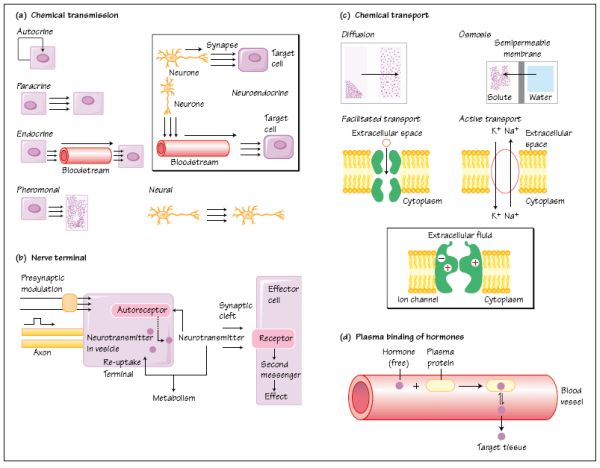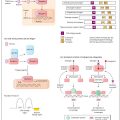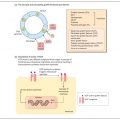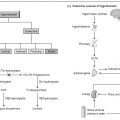
Classification of endocrine hormones
Hormones are chemical messengers. They may be classified several ways (Fig. 2a):
1 Autocrine: acting on the cells that synthesized them; for example insulin- like growth factor (IGF- 1) which stimulates cell division in the cell which produced it.
2 Paracrine: acting on neighbouring cells. An example is insulin, secreted by pancreatic b cells and affecting secretion of glucagon by pancreatic a cells.
3 Endocrine: acting on cells or organs to which they are carried in the bloodstream or through another aqueous ducting system, such as lymph. Examples include insulin, estradiol and cortisol.
4 Neuroendocrine: this is really paracrine or endocrine, except that the hormones are synthesized in a nerve cell (neurone) which releases the hormone adjacent to the target cell (paracrine), or releases it into the bloodstream, which carries it to the target cell, for example from the hypothalamus to the anterior pituitary gland through the portal system.
5 Neural: this is neurotransmission, when a chemical is released by one neurone and acts on an adjacent neurone (Fig. 2b). These chemicals are termed neurotransmitters. Neurotransmitters produce virtually instantaneous effects, for example acetylcholine, whereas some chemicals have a slower onset but longer lasting effect on the target organ, and are termed neuromodulators, for example certain opioids.
6 Pheromonal transmission is the release of volatile hormones, called pheromones, into the atmosphere, where they are transmitted to another individual and are recognized as an olfactory signal.
Basic principles of neurotransmission
When the nerve impulse arrives at the terminal, it triggers a calcium-dependent fusion of neurotransmitter packets or vesicles with the nerve terminal plasma membrane (Fig. 2b
Stay updated, free articles. Join our Telegram channel

Full access? Get Clinical Tree








